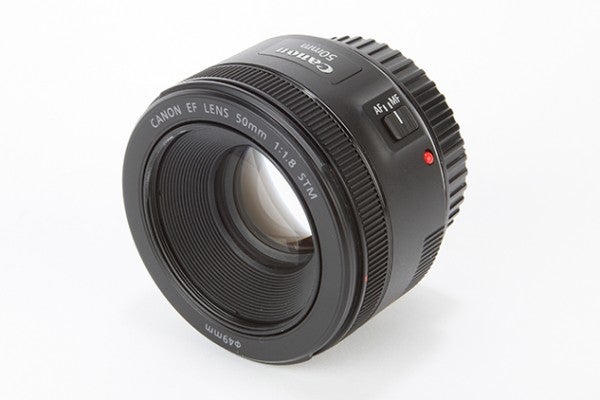It’s been a long time coming, but 25 years after the EF 50mm f/1.8 II was launched Canon has replaced its ‘nifty fifty’ with the new EF 50mm f/1.8 STM. Michael Topham finds out if it represents a bargain at just £129
Canon EF 50mm f/1.8 STM Review
Canon EF 50mm f/1.8 STM – Features
It should be pointed out that being an EF lens, the EF 50mm f/1.8 STM is fully compatible with both Canon full-frame DSLRs and those that employ an APS-C sensor. Coupled to the latter and with the 1.6x multiplication factor of an APS-C camera taken into consideration, the EF 50mm f/1.8 STM becomes a highly practical and creative short telephoto lens that’s equivalent to 80mm. To establish the lens’s optical performance across its full image circle, I tested it coupled to a Canon EOS 5D Mark III full-frame DSLR, on which it offers a 46° diagonal angle of view.

The new Canon EF 50mm f/1.8 STM (far right) alongside its predecessors
Just like the two previous generations of the lens, the EF 50mm f/1.8 STM employs a six-elements-in-five-groups arrangement. The main difference in its construction is that it now features seven rounded diaphragm blades, as opposed to the five straight blades used by its predecessor. This means it should give more attractively-blurred backgrounds at aperture settings smaller than about f/2.5 than the 50mm f/1.8 II, which gives pentagonal out-of-focus highlights that many photographers find rather ugly. It also has the ability to focus closer, to 35cm (1.15ft).
The standout feature is the designation of STM on the front of the lens denoting that it uses Canon’s Stepper Motor technology, which we’ve seen applied to a number of the manufacturers’ lenses since 2012. Unlike the more familiar Ultrasonic Motor (USM), a Stepper Motor is better at producing the precise incremental movements which are required by contrast-detection autofocus in live view. This is ideal for creating professional-looking focus transitions when recording video and can also help to eliminate any obtrusive operational noises that can potentially ruin a soundtrack.

Three generations of Canon ‘Nifty Fifty’ primes positioned side-by-side
Compared to previous incarnations, this lens is significantly quieter at focusing. Paired with a Canon EOS 70D that benefits from Movie Servo AF, the lens focused smoothly from near to far subjects and vice versa. However, it’s not wholly silent in operation and some low-pitch whirring was traced in indoor movie footage when there wasn’t enough ambient noise to cancel it out. As is the case for all STM lenses, manual focusing is the fly-by-wire type whereby the AF motor is activated by turning the focus ring.

The old and the new. The Canon EF 50mm f/1.8 II (left) alongside the Canon EF 50mm f/1.8 STM (right)
While using the lens to focus closely, it became obvious that the optical unit extends forward by approximately 15mm, operating across its full focus range with just over half a turn of the focus ring. In a similar fashion to its predecessors, it doesn’t suffer from a rotating front lens element, making it easier to use with polarising or neutral density gradient filters.
On the topic of filters, the EF 50mm f/1.8 STM has a filter diameter of 49mm, rather than the 52mm used on previous versions. So if you own either of the older EF 50mm f/1.8 or EF 50mm f/1.8 II lenses, and already have a number of 52mm filters, upgrading to this lens could incur additional expense with replacing them. A more economical solution would be to acquire a 49mm to 52mm step-up ring.





